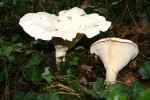 Giant funnel cup is a saprophytic fungus found growing in arcs or fairy rings in woodland clearings, open grasslands, and roadsides of Europe and North America . It is most common in the Rocky Mountains and Pacific Northwest, appearing in late summer to fall. The mushroom is four to six inches tall and has a cap six to sixteen inches across. The cap, gills and stem are dingy white to cream but the cap and gills may darken with age. The smooth cap is flat at first but becomes funnel shaped as it matures and has inrolled margins that become furrowed or split with age. The thin gills are crowded and run down the short stem. The stem can be up to 1.5 inches across and is firm when young before turning spongy. The spores are cream colored and turn blue in the presence of iodine.
Giant funnel cup is a saprophytic fungus found growing in arcs or fairy rings in woodland clearings, open grasslands, and roadsides of Europe and North America . It is most common in the Rocky Mountains and Pacific Northwest, appearing in late summer to fall. The mushroom is four to six inches tall and has a cap six to sixteen inches across. The cap, gills and stem are dingy white to cream but the cap and gills may darken with age. The smooth cap is flat at first but becomes funnel shaped as it matures and has inrolled margins that become furrowed or split with age. The thin gills are crowded and run down the short stem. The stem can be up to 1.5 inches across and is firm when young before turning spongy. The spores are cream colored and turn blue in the presence of iodine.
Although highly rated by some, others consider the giant funnel cap edible but not choice. The white flesh is compact and has an odor that is described as cyanic as well as mealy. The mushrooms are so large that one large one can feed several people. They should be eaten when young, then cut into strips and boiled before being incorporated into stews, casseroles, soups, risotto, or sauces for meat or fish. The water used for boiling should be discarded. Some people have reported digestive problems after eating giant funnel cap so a small quantity of the mushroom is recommended for first timers. Whenever collecting mushrooms from the wild, the advice of an expert on identification should be sought before eating them.
Photo Credit: By Strobilomyces – Own work, CC BY-SA 3.0, https://commons.wikimedia.org/w/index.php?curid=2606496